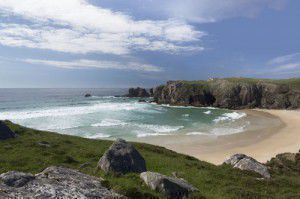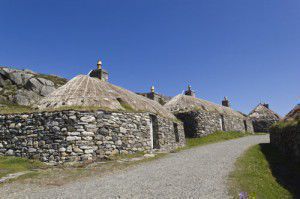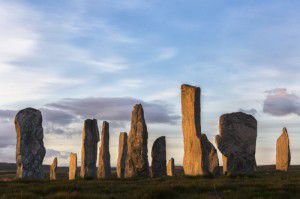10 reasons to visit… the Outer Hebrides
The scattered islands of the Outer Hebrides, off the Western coast of Scotland, are a haven of beauty, wildlife and mysterious archaeology. Tying in with last week’s Scottish Week here at EuroTalk, these are my top ten reasons to visit the islands, where Scottish Gaelic is still spoken as a native language.
We’d love to hear from residents or fans of this gorgeous part of the world – send us your tips!
1. The beautiful, beautiful scenery
Everybody, without exception, is blown away by the views on the Hebrides, where beaches are bright white and stretch out against a distant, uninterrupted horizon. The air is crisp and unpolluted and the seas, ever changing, create a dramatic backdrop to island life. Go driving and you might be the only person on the wide road for miles. Each of the islands has its own distinct geographical characteristics, from Lewis’ flatness to Harris’ mountains.
2. Black pudding
A local delicacy you’ll hopefully be presented with early on in your trip, Stornoway Black Pudding is now famous the world over. After a couple of slabs of it on your breakfast plate, you’ll not go hungry for the day, and if you’re feeling especially indulgent you might even round the meal off with a couple of kippers smoked in one of the island’s smokehouses. Yum!
3. Harris Tweed
Now internationally famous and found on Nike shoes, the tweed is traditionally made to protect against the extreme weather to be found on the island. It’s well worth taking a visit to one of the workshops or outlets to find out how it has been handmade by locals for centuries, up to the present day.
4. St Kilda
Admittedly, this is not a trip for the faint-hearted, as St Kilda lies a good eight hours’ travel by charter boat from the Hebrides, more from the mainland. Still, if you have time to play with, St Kilda is a fascinating trip. Its story of evacuation in the 1930s, after a period of extreme poverty and starvation, really hits home if you visit the museum, located in the homes of the original residents. The island is also a National Nature Reserve and a likely place to spot interesting flora and fauna.
5. The Blackhouse
You’ll find these in both the Highlands and Hebrides, and if you fancy you can even stay in one in the village of Gearrannan on Lewis, where the blackhouses have become visitor accommodation and you can experience for yourself the cosy, warm, smokey atmosphere. The blackhouse is a traditional home for both people (in one half) and their livestock (in the other), with the peculiar distinction that there is no chimney: instead, the smoke from the central hearth builds up and eventually filters through the thatched roof, creating a smokey, peaty and very warming atmosphere within.
6. Going to a whisky distillery
You can’t really miss this one, and generally in Scotland you’ll have a lot of local distilleries to choose from. On Lewis, you can visit the relatively new Abhainn Dearg distillery (the most westerly one in Scotland) and practice that all-important Gaelic word – Sláinte!
7. Ferries and planes
Island hopping around the Hebrides gives you the chance to see first-hand the vast differences in scenery, and character, of the many different islands. The archipelago is connected by a network of ferries, which, if you have a car, are well worth booking in advance to avoid being stranded somewhere for days. There are also a number of miniature plane journeys to be made, including the shortest ever flight, from Westray to Papa Westray, which takes a mere 1 minute 14 seconds. Don’t be alarmed if your plane only seats up to 8 people or if it lands, a little surprisingly, on the beach, as it does on Barra.
8. Rain
It’s probably a bit optimistic to expect perfect sunshine, even in the summer months, but luckily the Outer Hebrides look majestic in rain, and there is something deeply dramatic about the sudden and extreme downpour, swooping in within minutes, which can drench you to the skin. Nothing to worry about if you’re staying in the blackhouse and get to dry off in front of a peat fire, of course!
9. Wildlife
Undoubtedly this is one of the main reasons many people visit the islands. From the puffin to the golden eagle to the Minke whale, the islands, with their stunning natural beauty, are host to a rich variety of creatures which elsewhere are rarely seen.
10. Archaeology
Ranging from the very famous to the barely explored, the Hebrides are full of archaeological wonders from all ages. Perhaps the most well visited are the Callanish Stones on Lewis’ Western coast, which local legend (as often happens with standing stones) attributes to a group of naughty local giants turned to stone as punishment. Legends aside, the stones are enormous and imposing, and especially chilling if you manage to avoid the crowds and view them, early in the cold morning, huddled conspiratorially across the horizon.
Have we convinced you to give the Outer Hebrides a try? Don’t forget to learn a few words in Scottish Gaelic before you go…
Nat
It’s Raining Cats and Dogs (and Wheelbarrows and Old Ladies)
‘It’s raining cats and dogs!’ is a common British phrase meaning that it’s raining particularly hard. There are various theories as to where the expression came from – although there’s no evidence that it’s ever actually happened!
It may come from the Greek expression cata doxa. This means ‘contrary to experience or belief’ and might explain why the expression is used when it’s raining unusually hard.
Equally, it could be derived from the old French word catadupe, which meant waterfall.
An old theory was that in heavy rain, dead animals would often be washed out of drainage systems on 17th century buildings in Europe.
There’s no conclusive answer. It may just be that it was a funny expression that caught on and became popular. We’ll probably never know…
In Britain it also rains buckets, stair rods, tacks and pitchforks… But did you know that in other areas of the world, it rains other things?
Our favourites are:
‘It’s raining wheelbarrows’
Czech: Padají trakaře
‘It’s raining knives and forks’
Welsh: Mae hi’n bwrw cyllyll a ffyrc
‘It’s raining shoemakers’ apprentices’
Danish: Det regner skomagerdrenge
‘It’s raining fire and brimstone’
Icelandic: Það rignir eld og brennustein

‘It’s raining lady trolls’
Norwegian: Det regner trollkjerringer
‘It’s raining husbands’
Spanish: Están lloviendo maridos
‘It’s raining old women with knobkerries’
Afrikaans: Ou vrouens met knopkieries reen (by the way, a knobkierrie is a kind of African club!)
‘It’s raining snakes and lizards’
Brazilian Portuguese: Chovem cobras e lagartos
‘It’s raining frogs’
Polish: Leje zabami
We’d love to know where some of these expressions came from, so if anyone has any information, please share it in the comments!



